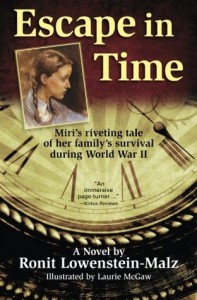

Nessya’s grandmother, Miri Eneman Malz, has friends, a loving family—and a secret: she is a Holocaust survivor. When twelve-year-old Nessya learns the truth, she wants to know what happened. After decades of silence, Grandma Miri decides it’s time to tell her story. It all begins one terrible day in the spring of 1944, when Germany crosses Hungary’s border and soldiers arrive in Miri’s hometown of Munkács. Suddenly, the Jews are trapped and in danger. Surrounded by war and unimaginable hatred, the family makes a daring escape. But that is only the beginning, and over the course of the year new threats continually confront them. Incredibly, despite numerous close calls, they defy the odds and live. Based upon actual memoirs, this is the story of the Eneman family . . . of their remarkable ingenuity, astonishing luck, boundless courage, and unending love.
Amazon.com
POTENTIAL TRIGGER WARNING: This novel does touch upon the topic of suicide.
Nessya is twelve years old when her Hungarian grandmother, Miri, reluctantly begins to share the darkest details of her Holocaust experience. Miri decides to write it all down, as she feels it will be easier to get the story out that way than if she were to speak the memories aloud.
"I wrote down the story of our family," Grandma said. "It is the story of the survival of two parents and their four daughters. One of the daughters, the youngest, was twelve years old when it all began. That girl is me. The world was at war, so instead of playing and learning, we were busy escaping and hiding. During this time, we quietly celebrated my thirteenth birthday. And while I had nothing to unwrap that year, no ribbons to untie, I received the most beautiful gift I could wish for: Life."
Through Miri's story, the reader is given specific details on how individuals and families were treated within the concentration camps. Such details covered:
> Mandatory curfews within Jewish communities prior to residents being forced to move to the camps; also business licenses of Jewish owners being revoked, removing the business owners' ability to provide for their families. There are descriptions within this book of some families being forced to cut up a dead horse to keep from starving to death themselves.
> Families were driven out of nice, clean communities into cramped, dirty ghettos. Miri's family was living with 4 other families in a one bedroom apartment in one such ghetto!
> While still residing in their towns, Jewish residents were forced to wear circular yellow patches signifying that they were Jewish. These were the precursors to the yellow stars Jewish people were forced to wear in the camps.
> Miri describes the children in her village learning how to speak in code from an early age, as well as learning to decifer coded letters from family during the war. In her story, she explains that there was a false sense of security that came with being educated and behaving cooperatively with the Nazi soldiers. You never knew who they were going to turn on. Miri's own father, Apu (aka Naftuli), was considered a doomsday-ish worrywart type with his gloomy prophecies about the Nazis, until his predictions started coming true.
I was, naturally, distressed by our chance in circumstances. Most of my belongings had been left at home, including my schoolbooks. I was, however, able to bring my geography text and a slim volume of some of Shakespeare's plays. Anyu had told me when she slipped them into my suitcase that with these books I'd always have the world in my hands and poetry in my heart.
Miri's tale also gives reader an idea of the lengths Jewish citizens had to go to to escape German capture: the complex escape plots; creating fake transportation / documentation papers, relocating and living under new names altogether; families sometimes forced to split up (maybe forever) as a matter of survival. As Nessya reads of the tension, anxiety and uncertainty swirling around her grandmother's fate, the reader feels Nessya's emotions right along with her. The author also works in an important idea at this point: It's easy to judge the past actions of our relatives / ancestors (and possibly how those choices affected later behavior) from the comfort of present day. Lowenstein-Malz illustrates this nicely with the description of Nessya reading her grandmother's words and feeling utterly heartbroken for her... but Nessya is reading these words sitting outside in the sun with a nice glass of iced tea and a plate of cookies.
This novel has a bit of a slow beginning, and while the book in its entirety is very short (less than 200 pages), there were passages that dragged a bit, sometimes reading more like a textbook than a novel. But the story does pick up and soon enough you are very much in Miri's world getting quite the education on this time period. The storytelling is enhanced by lovely pencil sketch illustrations done by Laurie McGaw.

Translated from the original Hebrew by Leora Frankel, this novel was first published in Tel Aviv, Israel in 2006 under the title A Miracle of Love. In 2008, it was awarded the Yad Vashem Prize for Children's Holocaust Literature. The English translation provides a handy pronunciation guide for the some of the Hebrew vocabulary and Jewish cities mentioned throughout the novel, but there were a few lines here and there where the English grammar still seemed just slightly off.
FTC Disclaimer: MB Publishing kindly provided me with a complimentary copy of this book in exchange for an honest review. The opinions above are entirely my own.









